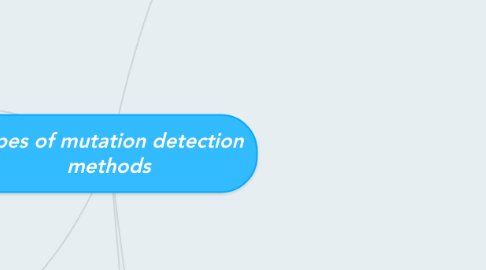
1. Heteroduplex Analysis with Single-Strand-Specific Nucleases
1.1. -Uses nucleases that cut single-stranded bubbles in heteroduplexes. -Region of interest is amplified by PCR. -PCR product is denatured and renatured with or without added normal PCR product. -Renatured duplexes are digested with nuclease; e.g., S1 nuclease. -Products are observed by gel electrophoresis.
2. Invader Technology
2.1. -Mutation detection with proprietary Cleavase enzyme -Sample is mixed with probes and enzyme. -Enzyme cleavage of probe-test sample hybrid will yield fluorescent signal. -Signal will only occur if probe and test sample sequence are complementary.
2.1.1. -Probes and enzyme are provided. -96-well plate format
3. Hybridization based methods
3.1. Single-Strand Conformation Polymorphism-(SSCP)
3.1.1. -Scans several hundred base pairs -Based on intra-strand folding -Single strands will fold based on sequence. -One base difference will affect folding. -Folded single strands (conformers) can be resolved by size and shape. -Strict temperature requirements
3.1.1.1. How to? 1. Amplify region to be scanned using PCR. 2. Denature and dilute the PCR products. 3. Separate conformers by PAGE or CGE. 4. Analyze results by comparison to reference normal control (+).
3.2. Allele-Specific Oligomer Hybridization-(ASO)
3.2.1. -Dot blot method -Relies on binding effects of nucleotide mismatches. -Specimen in solution is spotted on nitrocellulose. -Labeled oligonucleotide probe is hybridized to immobilized specimen.
3.2.1.1. How to? 1.Three specimens spotted on duplicate membranes. 2.One membrane exposed to probe complementary to the normal sequence (+ probe) 3.One membrane exposed to probe complementary to the mutant sequence (m probe). Chromogenic probe detection 1: normal (+/+) 2: heterozygous (m/+) m: heterozygous mutant control +: normal control N: negative control
3.3. Melt curves
3.3.1. -Based on sequence effect on Tm -Can be performed with or without probes -Requires double-strand DNA–specific dyes -Ethidium bromide -SyBrGreen -Also performed with fluorescence resonance energy transfer (FRET) probes
3.3.1.1. How to? 1.Double-stranded DNA–specific dye (SyBrGreen) will fluoresce when bound to DNA. 2.Denaturation of DNA to single strands will result in loss of fluorescence. 3.Every sequence has a characteristic Tm. 4.Melt curve Tm indicates which sequence is present.
3.4. Array technology
3.4.1. -Reverse dot blot methods -Used to investigate multiple genomic sites simultaneously -Unlabeled probes are bound to substrate. -Specimen DNA is labeled and hybridized to immobilized probes.
3.4.1.1. Array Technologies Methods
3.4.1.1.1. macroarray
3.4.1.1.2. microarray
3.4.1.1.3. high-density oligonucleotide arrays
3.4.1.1.4. microelectronic arrays
4. Sequencing (polymerization) based methods
4.1. -Sequence-specifc PCR (SSP-PCR)
4.1.1. How to? 1.PCR primer extension requires that the 3′ base of the primer is complementary to the template. 2.Primer design is used to detect mutations in DNA. 3.Generation of PCR product indicates the presence of mutation or polymorphism in the template.
4.2. -Allelic discrimination
4.2.1. -Uses fluorescently labeled probes -Similar to TaqMan technology -Generates “color” signal for mutant or normal sequence -Performed on real-time PCR instruments -Probe complementary to normal sequence labeled with FAM fluorescent dye -Probe complementary to normal sequence labeled with VIC fluorescent dye -Signals are detected and analyzed by the instrument software. -Multiple samples are analyzed simultaneously.
4.3. -Direct sequencing
5. Cleavage based methods
5.1. Restriction fragment length polymorphism (RFLP)
5.1.1. How to? 1.Restriction enzyme site recognition detects presence of sequence changes. e.g., G->A change creates EcoR1 site:

